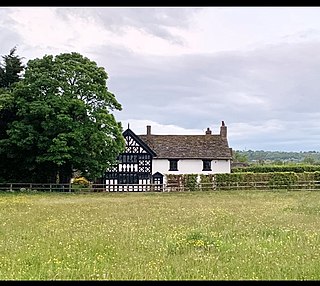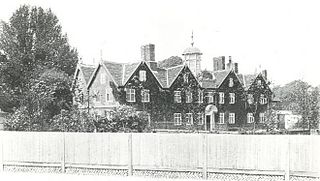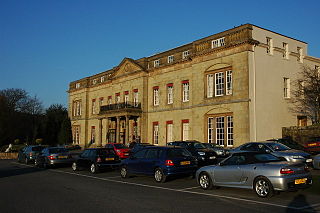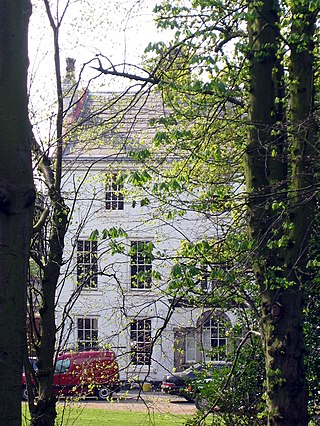
In the early 18th century the Oulton Estate was home to the Egerton family and comprised a manor house and a formal garden surrounded by farmland in Cheshire, England. Later in the century the farmland was converted into a park. The estate is now the site of the motor racing track called Oulton Park.

3–31 Northgate Street is a terrace of shops, offices and a public house on the west side of Northgate Street, Chester, Cheshire, England. All the buildings have a set-back ground floor with a covered walkway, are timber-framed in their upper storeys, and are listed buildings, being graded II* or II. The part of the terrace comprising numbers 5–31 is known as Shoemakers' Row, or Sadler's Row.

Peel Hall is a country house near the village of Ashton Hayes, Cheshire, England. It is recorded in the National Heritage List for England as a designated Grade II* listed building. It was built as a mansion in 1637, but was much reduced in size by 1812, and was later used as a farmhouse. It is constructed in sandstone and has slate roofs. Its architectural style is Jacobean.
Betchton Hall is a country house in the parish of Betchton, Cheshire, England. It was originally a timber-framed house, and was substantially rebuilt in brick in the 18th century for Richard Jackson, prebendary of Chester. In the early years of the following century it was extended for Richard Galley. The house is in two storeys. The southeast front has seven bays that include a round-headed doorway. The southwest front has three bays, and contains Venetian windows. The entrance hall is circular. In the house is an 18th-century fireplace moved from Faringdon House, then in Berkshire and now in Oxfordshire, in the 1960s. The house is recorded in the National Heritage List for England as a designated Grade II listed building.
Chorlton Hall is a country house to the east of the village of Backford, Cheshire, England.

Davenham Hall is a former country house to the southeast of the village of Davenham, Cheshire, England. It was built for Thomas Ravenscroft to replace a timber-framed house called Davenham Lodge. It dates from the middle or the later part of the 18th century, possibly from shortly before 1795, when Ravenscroft died. Substantial additions were made in the early 19th century. It is constructed in stuccoed brick, and has a slate roof. The house is in two storeys with a symmetrical entrance front of six bays. Occupying the middle two bays is a porch with four Tuscan columns and an entablature containing a triglyph. Above this, the central bays protrude slightly forwards and contain two windows, with a pediment above them and a parapet on each side. Figueirdo and Treuherz describe the interior as being "especially fine". The entrance hall contains Grecian plasterwork and a black marble chimneypiece. The drawing room has more delicate plasterwork, and a marble chimneypiece decorated with dancing figures. The central staircase hall is lit by a central dome, and has fan-shaped plasterwork. The staircase has a wrought iron baluster, and the first floor landing has a screen of four Doric columns. The house was converted into a nursing home in 1980. It is recorded in the National Heritage List for England as a designated Grade II* listed building.

Duddon Old Hall is a country house in the village of Duddon, Cheshire, England. It dates from the later part of the 16th century, the house was in the ownership of the Done family at this time. Alterations and additions were made in the early 19th century, and later in the century the timber framing was restored in 1903–4 and these works may be associated to local architect John Douglas of Chester. The timber framing was most recently extensively repaired between September 2021 and April 2022. It is constructed partly in timber-framing, and partly in brick, on a stone plinth. It is roofed partly in stone-slate, and partly in Welsh slate. The plan consists of a hall with a cross wing. The house is in two storeys, and its south front has four bays. The bay at the left end is timber-framed; it projects and has a gable with a bargeboard. The architectural historian Nikolaus Pevsner comments that the black-and-white decoration of this bay is "very rich". It consists of studding in the ground floor, lozenges and shaped balusters in the upper floor, and lozenges and serpentine struts in the gable. In the adjacent bay is a wooden doorcase with a triangular pediment. All the windows are casements. Internally, the main chamber is in the cross wing, which is open to the roof. The house is recorded in the National Heritage List for England as a designated Grade II listed building. To the northeast of the house is a 16th-century barn, constructed in timber-framing with brick infill, which is also listed at Grade II.

Hankelow Hall is a former country house to the north of the village of Hankelow, Cheshire, England.

Hawthorn Hall is a former country house in Hall Road, Wilmslow, Cheshire, England. It originated in about 1610 as a timber-framed yeoman house for John Chavman of mnc. It was improved and encased in brick for John Leigh in 1698. Its use changed in the 19th century, and in 1835 it opened as a homeless shelter school. During the 1960s the house served as a private residence. The building has since been used as offices. It is constructed in plum-coloured brick, with a Kerridge stone-slate roof, a stone ridge, and three brick chimneys. Parts of the timber-framing can still be seen in the roof gables, and in an internal wall. The plan consists of a long rectangle. The house is in 2½ storeys, and has a near-symmetrical north front. There are four gables with bargeboards and mace finials. Each gable contains a pair of wooden mullioned and transomed windows. In the centre is a doorway, flanked by plain pilasters, and surmounted by a segmental hood framing a cartouche containing the date 1698. At the top of the hall, above the door, is a small balustrade, behind which is a half-glazed lantern with a cupola and a weathervane. The south front is similar to the north front, although the door is not central. This door is flanked by fluted pilasters, and surmounted by a plaque with a lion rampant. The east front has two gables. The architectural historian Nikolaus Pevsner comments that the house is "good to look at, though conservative for its date". The house, together with parts of the garden walls, is recorded in the National Heritage List for England as a designated Grade II* listed building.
Ingersley Hall, later Savio House, stands to the east of the town of Bollington, Cheshire, England. The house was built in about 1775 for John Gaskell. Extensions were added to it in 1833 for John Upton Gaskell. The house was sold by the Gaskell family in 1933. In the 1950s it was taken over by a religious order, the Salesians of Don Bosco, and renamed Savio House. As of 2011 the house is used as a retreat and activities centre for young people. The front of the house is constructed in ashlar, with the remainder in coursed sandstone rubble. The house is roofed in Welsh slate and has stone chimneys. It has a rectangular plan and is in two storeys. The architectural style is Greek Revival. The north front is symmetrical with five bays divided by pilasters. The porch is in Doric style. The west front has eight bays, the central three of which were in the original house. All the windows in the north and west fronts are sashes with 12 panes. The south door is in Tuscan style, and was probably moved from the west front. The house is recorded in the National Heritage List for England as a designated Grade II listed building. Also listed at Grade II is a former coach house to the south of the hall, built in about 1850, and converted into a conference hall in about 1950.
Lymm Hall is a moated country house in the village suburb of Lymm in Warrington, Cheshire, England. It is recorded in the National Heritage List for England as a designated Grade II* listed building.

Over Tabley Hall is a country house in the parish of Tabley Superior in Cheshire, England. It stands in an isolated position to the northwest of junction 19 of the M6 motorway.

Shrigley Hall is a former country house standing to the northwest of the village of Pott Shrigley, Cheshire, England. It has since been used as a school, when a chapel was added, and later as a hotel and country club operated by The Hotel Collection.

Stretton Hall is a country house in the parish of Stretton in Cheshire, England. It was built in about 1763 for John Leche. The house is constructed in brick on a sandstone basement, with painted stone dressings, and a slate roof. It has three symmetrical elevations. The entrance front is in three two-storey bays with a single-storey wing on each side. The central bay is canted, with five steps leading up to a doorway with a pediment. The windows are sashes. The garden front has similar windows, other than the wings, each of which contains a Venetian window. To the right of the house is attached a further wing, converted from the 17th-century stable of an earlier house. The house and former stable area is recorded in the National Heritage List for England as a designated Grade II* listed building. The sandstone garden walls are listed at Grade II.

Tattenhall Hall is a country house standing to the south of the village of Tattenhall, Cheshire, England. The house is designated by English Heritage as a Grade II* listed building.

Whirley Hall is a country house standing to the north of the village of Henbury, Cheshire, England. The house dates from about 1670. Additions and alterations were made during the 18th century and in the 1950s, when the house was restored and wings were added at the sides. The house is constructed in brick with buff sandstone dressings, and has a Kerridge stone-slate roof with stone ridges. It has three storeys and symmetrical five-bay front. Between the storeys, and above the top storey, are brick bands. The lower two storeys contain 20th-century wooden-framed mullioned and transomed windows. In the top storey are two-light casement windows. Above these are two shaped gables, each surmounted by an obelisk finial, and containing an elliptical window. There are single-storey, two-bay extensions on each side of the house. In the roof of the house is a stone inscribed with the date 1599, which is considered to have been removed from an earlier timber-framed house. The house is recorded in the National Heritage List for England as a designated Grade II* listed building. The gate pier in front of the house is a Grade II listed building.

Hapsford Hall is a country house about 1 mile (1.6 km) south-west of Helsby, Cheshire, England. It was built in the late 18th or early 19th century and incorporates a former farmhouse; additions and alterations have been made since it was built. It is constructed in brick and stone, stands on a stone plinth, and has stone quoins and a hipped slate roof. The house is in three storeys, with cellars and an attic, and has a symmetrical front of three bays. Most of the windows on the front are sashes; elsewhere are casement windows. An embattled stone porch projects from the centre. The house is recorded in the National Heritage List for England as a designated Grade II listed building.

Moore Hall is a country house located in the village of Moore, Cheshire, England. It was built in the early 18th century, and is constructed in roughcast brick with a slate roof. The house has three storeys, and is in five bays. The porch is a more modern, and is fronted by a Venetian window. The windows are sashes. The house is recorded in the National Heritage List for England as a designated Grade II* listed building.

Sutton Hall is in the village of Little Sutton, Cheshire, England. It is recorded in the National Heritage List for England as a designated Grade II listed building.

Bache Hall is a former country house in Bache, Chester, Cheshire. It replaced an earlier house that had been damaged in the Civil War. At one time a golf club house, then a hospital building, as of 2013 it provides residential accommodation for university students. The hall is recorded in the National Heritage List for England as a designated Grade II listed building.

















